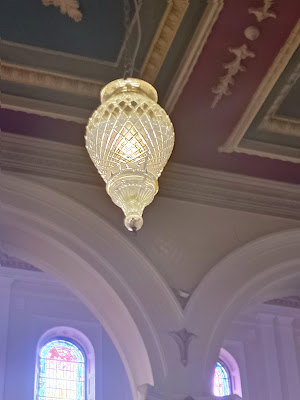For a lifelong Dubliner, my knowledge of Dublin geography is astonishingly bad. If you'd asked me where Balally was this time last week, I would have shrugged my shoulders, and not even known it was in Dublin. In terms of my own experience, it's close to the Beacon Hospital, which has featured prominently in my recent life. That puts it on the south side of Dublin city. There are lots of car showrooms in this area, which indeed seems more amenable to motorists than pedestrians.
The church is beside a small, rather run-down shopping centre.
This is how the church's website describes itself: "The Parishioners of Balally built this Church with great effort and generosity. It was finished in 1982. Many of the first Parishioners are still active in the community, and many have gone home to God.
"The Church structure is unusual as Churches go, but its building was inspired by the Second Vatican Council. Its layout highlighted the belonging to the family of God. From the tapestry of the Burning Bush (at the very centre behind the Tabernacle) the walls extend like open arms and embrace all who enter and immerse them in the Divine Presence. That Divine Presence is underscored by each of the windows which are dedicated to the opening verses of the Book of Genesis.
"The configuration of the building facilitates the participation of each and every member in the liturgy. No one feels far away or distant from the Altar, and all can be seen. At the middle of the Altar, there is the icon of the Washing Of The Feet inviting all who enter to serve others as Christ has served us."
There is also a John Main Icon Chapel attached to the church, though it wasn't opened when I visited. I suppose, dear reader, you've had the experience of hearing about something for the first time and then hearing about it again surprisingly soon after. The Benedictine priest-monk and promoter of Christian meditation, Fr. John Main, crossed my radar for the first time only a few weeks ago. It felt very strange that I discovered a chapel dedicated to him so soon after.
I attended Balally church on a Saturday evening, for Vigil Mass. Access to the church is through the parish centre. There was a fairly large congregation, mostly elderly but with a fair sprinkling of young people. Interestingly, there is a portrait of Blessed Columba Marmion hanging beside the altar.
Sadly, the most memorable part of my visit to Balally church was a serious liturgical abuse that I witnessed. Most of the communicants took the Host from one extraordinary minister, walked to another extraordinary minister, and dipped the Host into the Precious Blood. I felt pretty sure this was a serious abuse when I witnessed it, and I confirmed it later. (See here for one of the many, many sources that clarify this.) I'm sure the parishioners have no idea that there's anything wrong with this, but the priest should know better. The Creed was also left out "because the Gospel was so long".
As for the church itself, I liked it well enough, although it was a bit dark for my taste. It's certainly very modern, but I don't mind that.
The one element that I found jarring was the crucifix above the altar, which shows Jesus making a peace sign with his left hand. Of course, our Lord's arms were nailed into the cross, which makes this depiction rather incongruous. Nobody says a crucifix has to be realistic, especially since our Lord's Passion has a timeless element to it, as well as an historic one. But there's a certain bathos to the image.
The congregation chanted a mantra after Mass: the word "maranatha", which also features in the decoration of the altar. I suppose this is appropriate enough, given the connection to Fr. John Main. The priest introduced it as "our mantra", so it's obviously a regular thing. Which is fine. But if you have time for an extra-liturgical addition like a mantra, you should have time for the Creed.
From now on, I'm going to dedicate a single blog post to each church. And don't worry, the blog isn't going to be completely dedicated to this "trek" from now on.


















































